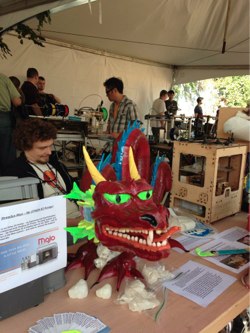Working my way past the butterfly bikes at the entrance to the Maker Faire this Saturday in Queens, I met up with BeagleBoard.org cofounder Jason Kridner. In the viewscreen of his duct-tape and cardboard hacked BeagleStache camera I looked like a befuddled bandido. Directed by the underlying BeagleBone Black board, the moustache overlay followed me no matter which way I moved.
 “I used OpenCV to do this,” said Kridner. He noted that although the C/C++ library is primarily aimed at the desktop, “They have all sorts of APIs you can use in embedded if you have a desktop-level processor like the Sitara.”
“I used OpenCV to do this,” said Kridner. He noted that although the C/C++ library is primarily aimed at the desktop, “They have all sorts of APIs you can use in embedded if you have a desktop-level processor like the Sitara.”
Kridner pulled out an LED-studded belt attached to a BeagleBone Black. Different movements of the belt caused various lighting sequences. “There’s a lot of stuff being done with lighting on the BeagleBone,” said Kridner. At the recent Burning Man, for example, a lighting project called the Disorient Pyramid incorporated a half a kilometer of LED strips, all controlled by a BeagleBone and a Panasonic Toughbook.
We continued our discussion as we crossed the cheerful chaos of the open air exposition, which totaled nearly 70,000 visitors by the end of the weekend. The BeagleBone Black was selling well, Kridner continued, as we passed three men in suits wearing GhostBuster packs. Meanwhile, he added, most of the backward compatibility issues for capes caused by the switch to the Device Tree data structure in Linux 3.8 have been solved.
Nearby at the aerodrome, DIY rocketeers were shooting their crafts into the air while quadrocopters buzzed nearby. Kids ran in large numbers through the crowd, and joined adults working and playing in tents set aside for DIY crafting using fabric, wood blocks, beads, and 3D-printed plastic objects.
Mixed in with the Etsy crowd and the high tech hackers, you could find gearheads racing modified toy cars in the Power Racing Series competition. Meanwhile, human-powered vehicle inventors showed off steampunk creations like a bicycle-fueled root vegetable cleaner.
OpenROV 2.5 and Logi-Bone and Logi-Pi boards
 Robots were everywhere. Nearby, the OpenROV underwater vehicle was swimming gracefully around a pool. Fresh from receiving a $1.3 million infusion from True Ventures, the successful Kickstarter project was showing version 2.5 of the aquatic robot. OpenROV runs Linux on a BeagleBone Black instead of the original White, and features a Atmega 2560-based control board running Arduino instead of the earlier BeagleBone cape.
Robots were everywhere. Nearby, the OpenROV underwater vehicle was swimming gracefully around a pool. Fresh from receiving a $1.3 million infusion from True Ventures, the successful Kickstarter project was showing version 2.5 of the aquatic robot. OpenROV runs Linux on a BeagleBone Black instead of the original White, and features a Atmega 2560-based control board running Arduino instead of the earlier BeagleBone cape.
The ValentFX booth, meanwhile, displayed a drink-serving BBot robot that runs Linux on a BeagleBone connected to the company’s Logi-Mark1 FPGA board. The company also demonstrated new Logi-Bone and Logi-Pi versions of the boards designed to interconnect with either a BeagleBone Black or Raspberry Pi, respectively.
According to ValentFX founder Michael Jones, the interconnect may not as be as fast as boards based on a Xilinx Zynq system-on-chip, which integrates ARM and FPGA subsystems, but the Logi boards are easier to develop for, and a lot cheaper. The fully open source products are not yet available, but ValentFX is talking to distributors and considering a Kickstarter campaign.
In the same tent, Kridner and Arduino co-founder Massimo Banzi greeted each other warmly. In the open source board world it’s just as much about being co-conspirators than it is being rivals.
Arduino was dominant at the show, but there were a number of Raspberry Pi and BeagleBone based projects as well. Like the OpenROV and Logi boards, several were ARM/Arduino hybrids. For example, the Udoo community-backed board combines a Freescale i.MX6 chip running Android or Linux with an Arduino Due-compatible subsystem. Udoo was demonstrating motion sensor and imaging applications.
Arduino is now shipping its own Arduino/Linux hybrid Arduino Yún board. Kridner wants to persuade Arduino users that the BeagleBone offers most of what they need plus a faster processor, Linux, and more, but he concedes that in many cases Arduino is the better choice.
Still, the Yún is not the answer, said Kridner. “Its MIPS Linux implementation seems too limited, but we’ll see,” he added. “Linux does have its limitations in controller applications, but the nice thing about the BeagleBone is you can use Linux for higher level tasks, but still directly code to a microcontroller. Sometimes, the microcontroller code makes Linux look good.”
Other kits and devices built on the Raspberry Pi, which was more evident than the BeagleBone in the hobbyist kits on sale in the Maker Shed. The Pi Foundation’s Eben Upton was also expected to show off a new Pi-noir night-vision camera module for the Pi.
 Intel’s Linux- and Atom E640-based, MinnowBoard was also on hand. The project demonstrated a computer vision gizmo based on the open source, Yocto-compatible MinnowBoard and the OWI Robotic Arm. The partially OpenCV-driven “MinnowBoard Fish Picker-Upper” picked up only those objects shaped like a fish.
Intel’s Linux- and Atom E640-based, MinnowBoard was also on hand. The project demonstrated a computer vision gizmo based on the open source, Yocto-compatible MinnowBoard and the OWI Robotic Arm. The partially OpenCV-driven “MinnowBoard Fish Picker-Upper” picked up only those objects shaped like a fish.
An 8-year old asked where the computer was. “That is the computer,” the rep said, pointing at the tiny board. “Oh,” he said, and then asked the MinnowBoard’s price. When he heard “$199,” the kid blew through his lips, and turned away. “Not for me!”
Indeed, there’s a strong ethos of cheap and dirty at the Maker Faire. Yet the Faire has also become the center of a fast-growing 3D printer industry that some hail as the harbinger of a new industrial revolution. There were dozens of 3D printers in action, while other booths sold software and services. The industry is still buzzing over the recent acquisition of Brooklyn-based MakerBot by Stratasys, which sets up three main players, at least for now: Stratasys/MakerBot, 3D Systems, and the numerous products and vendors supporting the open source RepRap platform.
Some of the 3D printers ran on Arduinos, but more had custom circuitry. Although 3D printer hacks have integrated Raspberry Pi or BeagleBone boards, I didn’t see any here. Nobody seemed to know of any commercial Linux-based 3D printers on the horizon, although most reps were quick to note their support for desktop Linux.
A Linux-driven 3D printer for circuit boards
Kridner did show me one BeagleBone-driven device that is similar to a 3D printer. At the Tempo Automation booth, cofounder Jeff McAlvery demonstrated a prototype of an Electronics Factory desktop robot for manufacturing circuit boards in short-runs. The device etch traces, applies solder paste, places components, reflows, and tests boards. It incorporates Synthetos’ TinyG multi-axis motion control board, which in turn integrates with the Linux-based BeagleBone or Raspberry Pi.
“In many ways the BeagleBone is ideally suited for this,” said McAlvery as Kridner stood nearby. “It has the high-level processor and Linux development environment, but also has the analog interfaces, the controller side.” McAlvery wasn’t sure about a timetable, but said he was considering crowdfunding.
We also stopped by the Synthetos booth where they demonstrated a stepper motor working in conjunction with the TinyG, here paired with a Pi. Designed for CNC applications, TinyG is built around an Atmel ATxmega192 microcontroller and is programmed using open source LinuxCNC-compatible Gcode downloaded via USB. The TinyG V8 version implements “constant jerk acceleration planning” algorithms for fast, yet smooth, transitions that avoid whiplash.
Very interesting. But not as cool as the World’s Biggest Mousetrap, a 25-ton replication of the Rube Goldberg game spread over an entire field. Should I ask the clowns whether it runs Linux?


